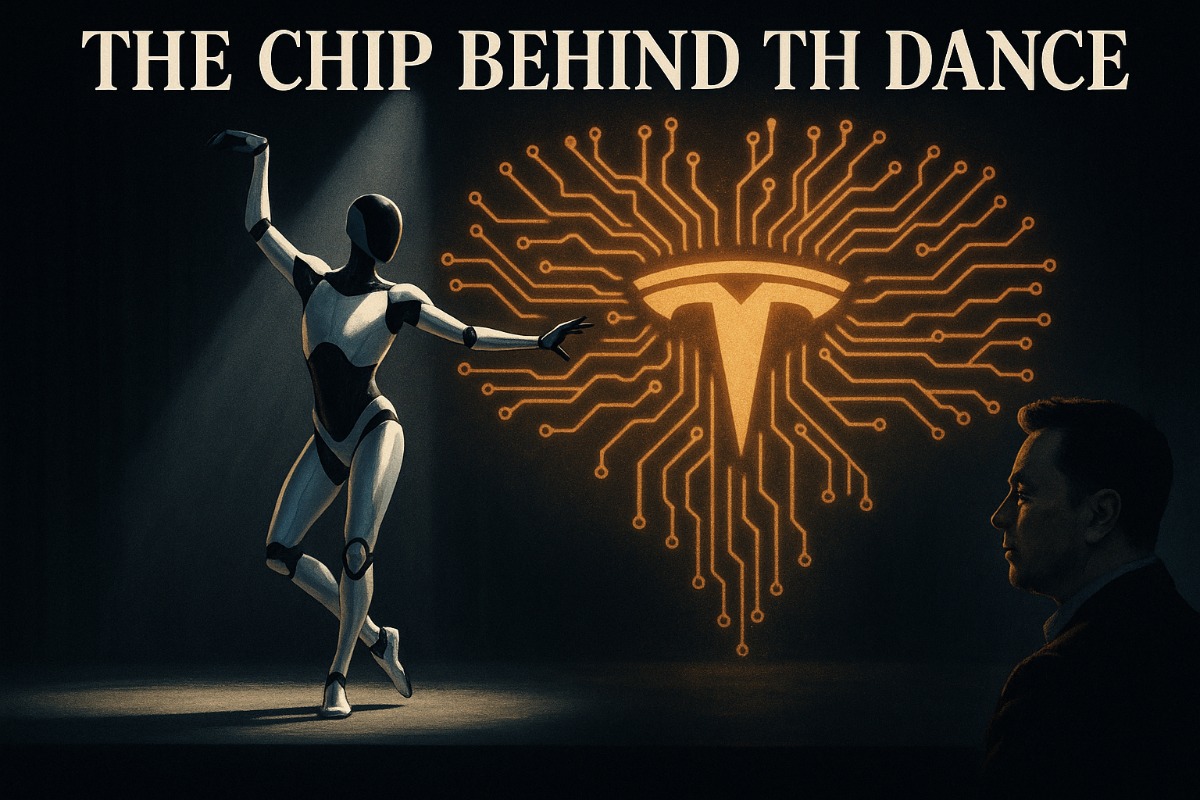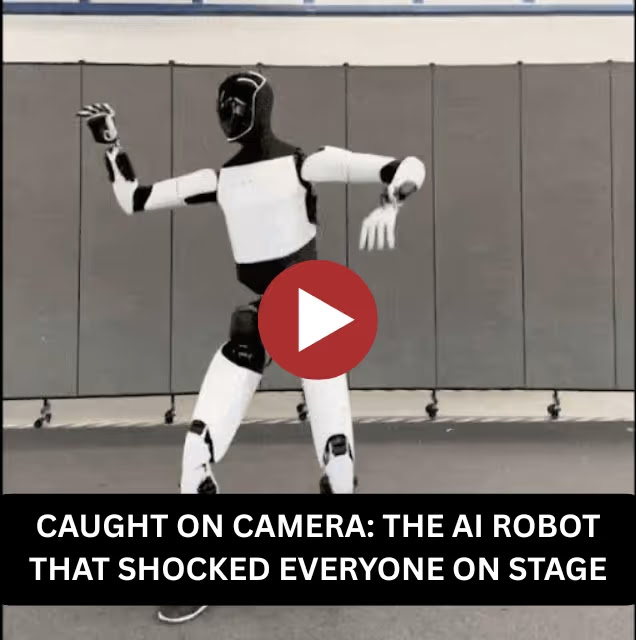Elon Musk’s Dancing Robot Just Exposed a Hidden $1 Trillion Opportunity
Oct 17, 2025 5:41 pm
Elon Musk’s Dancing Robot Just Exposed a Hidden $1 Trillion Opportunity
Tesla’s humanoid robot isn’t just science fiction - it’s the first signal of a new AI hardware revolution. And one company quietly holds the key.
TradeTalksLive - “The Chip Behind the Dance”
At first, it danced.
Flawlessly. Effortlessly. Like it had trained for years.
But it hadn’t.
It simply watched - then did.
That was Optimus, Tesla’s humanoid AI robot.
Unveiled by Elon Musk on stage before a stunned audience, it wasn’t a performance — it was a demonstration.
A moment that blurred the line between code and consciousness.
Optimus stirred a pot.
Vacuumed.
Cleaned a table.
All by observing human motion - and replicating it perfectly, without being explicitly programmed.
The crowd cheered.
Twitter (or X, as Musk insists we call it) exploded.
And the market - as usual - missed the point.
Because what Musk showed wasn’t a gimmick.
It was a glimpse of the next trillion-dollar industry.
The Real Story Behind the Robot
When you strip away the headlines, the viral clips, and the memes, one thing becomes crystal clear:
Optimus isn’t about humanoid helpers.
It’s about data.
Each gesture, each movement, each object recognition sequence is powered by millions of micro-decisions per second, processed through a chip so advanced it makes traditional computing look prehistoric.
That chip - and the company behind it - is where the real money will be made.
And according to analysts close to the project, only a handful of firms in the world have the hardware capable of training, processing, and executing real-time AI motion like this.
One of them, still under Wall Street’s radar, could become the next Nvidia.
Sponsored Content from Brownstone Research
Caught on Camera: The AI Robot That Shocked Everyone on Stage
At first, it danced.
Flawlessly. Effortlessly. Like it had trained for years. But it hadn’t.
It simply watched — then did.
That was Optimus, Tesla’s humanoid AI robot. Revealed by Elon Musk in front of a stunned audience.
What followed wasn’t a scripted show. It was a real-time demonstration of a machine capable of learning like a human — but adapting like no human ever could.
It stirred a pot. Vacuumed. Cleaned a table. All through observation, not programming.
The world saw entertainment. Investors saw a trillion-dollar inflection point.
Because powering this machine is a chip — and behind that chip is a company few have ever heard of.
>> Click here to discover the stock tied to the AI robot that danced its way into history
AI Has Learned to See - Now It’s Learning to Move
For the last decade, artificial intelligence has been all about language and vision.
It learned to recognize faces, generate text, and paint pictures.
But now, it’s entering the physical world.
That transition - from digital intelligence to embodied intelligence - is the single biggest technological leap since the internet.
And it requires a completely different kind of computing power.
We’re talking chips that don’t just calculate - they react.
Processors that interpret depth, light, movement, and spatial context in milliseconds.
Tesla’s secret weapon isn’t the robot’s shell or servos - it’s the AI brain inside it.
And while Tesla designs much of its own hardware, the ecosystem that feeds those systems - from microfabrication to sensor integration - involves dozens of companies that investors can still access.
That’s why the smartest money in Silicon Valley isn’t just chasing software anymore.
They’re quietly pouring billions into AI hardware - the tangible infrastructure of this new world.
A Trillion-Dollar Inflection Point
Let’s be clear: humanoid robots aren’t “around the corner.”
They’re already here.
Optimus may be Tesla’s headline grabber, but it’s not alone.
Boston Dynamics, Agility Robotics, and Figure AI are all pushing into commercial-ready humanoid platforms designed to replace repetitive, dangerous, and low-skill labor.
From warehouses to hospitals, these machines are being tested in real-world environments.
And as adoption accelerates, one thing becomes obvious - they’ll all need chips powerful enough to simulate human cognition.
That’s why this moment matters.
Because every generation of computing - from the PC to the smartphone to the cloud - had a single hardware breakout that turned early investors into legends.
- Intel in the 1980s.
- Nvidia in the 2010s.
- And now, a new AI hardware pioneer rising in 2025.
The Market Is Sleeping on Physical AI
The mainstream narrative is still fixated on ChatGPT clones and language models.
But the next stage of AI isn’t about words.
It’s about motion.
Think logistics centers where robots unload trucks autonomously.
Construction sites with self-assembling materials.
Hospitals where mechanical nurses assist surgeons in real time.
These aren’t sci-fi dreams - they’re active pilot programs in China, Germany, and the U.S.
And every one of them depends on breakthroughs in edge AI chips - hardware capable of processing massive amounts of sensory data without cloud latency.
That’s the market’s blind spot.
While investors crowd into OpenAI and Google, the companies building the silicon backbone of physical AI are scaling quietly - and fast.
Elon’s Real Mission
Musk never hides his endgame.
He’s been blunt about it for years: “AI that can do physical tasks will change civilization itself.”
But here’s the detail most people miss - Tesla’s real business isn’t cars, it’s automation.
Every Tesla vehicle, every factory robot, every satellite uplink feeds data into one massive neural network that teaches machines how to think.
And once that neural model is perfected, it won’t just drive cars.
It will run the world’s labor infrastructure.
That’s why the robot danced.
It wasn’t a publicity stunt.
It was a proof of concept - a live demonstration of human-like motion powered by self-learning computation.
And investors who recognize what that means have a once-in-a-generation window to get in before the hardware ecosystem behind it explodes.
Where the Smart Money’s Moving
Insider filings show a flood of venture capital into companies focused on three areas:
- AI Chip Fabrication: Designing processors optimized for autonomous motion.
- Energy Systems: Battery architectures that can power high-efficiency robotics.
- Sensor Fusion: Advanced perception modules that replicate human senses.
One or two of these firms are publicly tradable. Most are still under radar - but one in particular, the same one feeding into Tesla’s AI supply chain, could emerge as the next 100-bagger.
That’s the company the analysts in “Behind the Markets” are naming in their new investor briefing.
Because when the robot moved, they realized - the next Nvidia moment had just begun.
The Bottom Line
When Musk unveiled Optimus, the audience laughed.
Then it walked.
Then it learned.
Now, no one’s laughing.
Because once machines can learn by seeing, they can work without limit.
That’s not automation. That’s evolution.
And just like every technological revolution before it - from steam to silicon - the ones who recognize the inflection point before everyone else make history.

